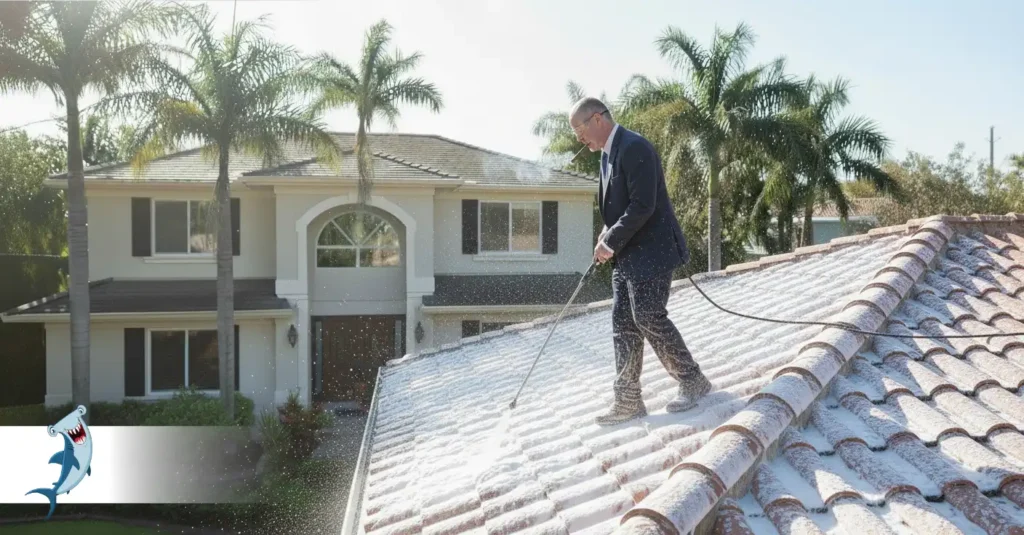
Power Wash Roof – Naples Florida
Your roof plays a vital role in protecting your home, but over time, it can accumulate dirt, algae, and mildew that cause discoloration and deterioration. At Naples Pressure Washing and Roof Cleaning, we specialize in power wash roof services that safely and effectively clean your roof, restore its natural beauty, and extend its lifespan.
Why Roof Power Washing Is Important
In Naples’ humid climate, roofs are highly prone to mold, black streaks, and algae buildup. These contaminants don’t just affect your home’s appearance — they can also shorten the life of your roof materials and lead to higher energy costs. A professional power wash roof service removes harmful buildup, improving your roof’s efficiency and curb appeal while preventing premature wear. Additionally, utilizing an ecofriendly roof wash effectiveness can enhance the cleaning process without harming the environment. This method not only effectively eliminates mold and algae but also contributes to the longevity of your roofing materials through safe, gentle cleaning techniques. By choosing ecofriendly solutions, homeowners can enjoy a cleaner roof while supporting sustainable practices.

Professional Equipment and Trained Technicians
At Naples Pressure Washing and Roof Cleaning, we use specialized soft washing equipment to deliver a safe and effective roof power wash. Unlike traditional high-pressure methods that can damage shingles or tiles, our low-pressure cleaning process removes dirt, algae, and stains without harming your roof’s surface. Our team is dedicated to ensuring your roof looks its best while maintaining its integrity. In addition to roof cleaning, we offer comprehensive power washing services in Naples for your driveways, patios, and exterior surfaces. Trust us to enhance your home’s curb appeal while protecting your investment for years to come. Our soft wash roof cleaning services are designed to extend the lifespan of your roof, ensuring it remains in optimal condition. By utilizing eco-friendly cleaning solutions, we not only prioritize the safety of your home’s materials but also protect the surrounding environment. Experience the difference our expert team can make in restoring your roof’s appearance and functionality.
We clean all roof types, including:
- Tile and shingle roofs
- Metal and flat roofs
- Asphalt and slate roofing
- Roof overhangs, soffits, and fascia boards
Safe and Eco-Friendly Roof Cleaning Solutions
We use biodegradable, eco-friendly detergents that kill mold and algae at the root while being safe for your home, pets, and landscaping. Our cleaning process ensures your roof is fully cleaned without runoff damage or residue, leaving it spotless and protected for the long term.
Why Choose Naples Pressure Washing and Roof Cleaning
- Local Experts: Proudly serving Naples, Bonita Springs, and Marco Island.
- Roof Cleaning Specialists: Experienced technicians who understand Florida’s roofing materials.
- Affordable Services: Professional results at fair, competitive rates.
- Guaranteed Satisfaction: We deliver clean, long-lasting results every time.
Protect and Extend the Life of Your Roof
Regular power wash roof maintenance prevents algae and debris buildup, extending the life of your roof and improving your home’s energy efficiency. A clean roof also enhances your home’s appearance and prevents costly future repairs caused by organic growth and water retention. Additionally, engaging professional power washing services in Naples ensures that the cleaning is done safely and effectively, minimizing the risk of damage to your roofing materials. Regular maintenance through these services can identify potential issues early, saving you money in the long run. Ultimately, investing in your roof’s upkeep reflects positively on your home’s overall maintenance and value.
Schedule Your Roof Power Wash Service Today
Restore your roof’s original look and strength with a professional power wash roof service from Naples Pressure Washing and Roof Cleaning. Whether it’s tile, shingle, or metal, our team will make your roof look brand new while protecting your home’s structure. Our comprehensive roof cleaning services in Naples are designed to remove dirt, algae, and mold, ensuring the longevity of your roof. Trust our experienced professionals to use environmentally friendly techniques that safeguard your home and enhance curb appeal. Experience the difference with a clean roof that not only beautifies your home but also increases its value. In addition to our power wash roof service, we also offer comprehensive house washing services in Naples that complement our roofing solutions. This ensures that every aspect of your home’s exterior is meticulously cleaned, enhancing the beauty and longevity of your investment. Choose us for a complete transformation that not only protects your roof but elevates the entire appearance of your property.
Technical & Scientific References
📞 Call us today or request a free quote online — and give your roof the professional care it deserves!
